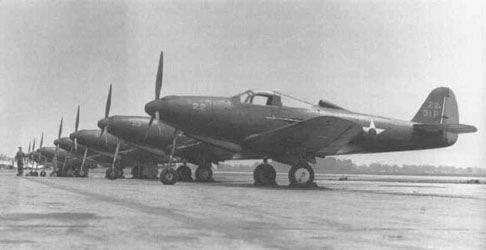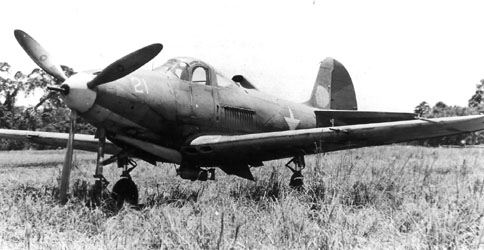| /Airplanes/Allies/USA/01-Fighters/P-39Airacobra/P-39C_Airacobra.htm | Update: 06-09-2015 | |||||||||||||||||||||||||||||||||||||||||||||||||||||||||||||||||||||||||||||||||||||||||||||||||||||||||||||||||||||||||||||||||||||||||||||||||||||||||||||||||||||||||||||||||||||||||||||||||||||||||||||||||||||
P-39 Airacobra - Variants (P-39C) /Left.jpg)
/TopBelly.jpg)



P-39C (Bell 13, P-45) Premier modèle de série du Airacobra. Un temps envisagé être livré en tant que P-45, il sera en définitive livré sous l'appelation P-39C à partir de 1941. Le P-39C était semblable au YP-39 à lexception du moteur remplacé ici par un V-1710-35 développant 1150 cv. L'armement consistait en un canon de 37 mm (1.46 in), 2 mitrailleuses de .50 in (12.7 mm) et deux mitrailleuses de .30 in (7.62 mm). 80 modèles furent commandés mais 20 seulement seront livrés en tant qu e P-39C, les 60 autres feront parties des premières livraisons du P-39D. Malheureusement, le chasseur n'est pas encore apte pour le combat en raison de l'absence de blindage protégeant le pilote et de réservoirs auto-obturants (empêchant l'avion de s'embraser au moindre impact). First model series of
Airacobra. Proposed a time to be be delivered as P-45, it will ultimately
be delivered under the name P-39C from 1941. The P-39C was similar to
the YP-39 except for the engine replaced here by a V-1710 -35 developing
1150 hp. The armament consisted of a 37 mm gun (1.46 in), 2 machine
guns .50 in (12.7 mm) and 2 machine guns .30 in (7.62 mm). 80 models
were ordered but only 20 will be delivered as P-39C, the other 60 will
be part of the first deliveries of the P-39D. Unfortunately, the fighter
is not really fit for the fight due to the lack of armor protecting
the pilot and self-sealing fuel tanks (preventing the aircraft burst
into flames at the first impact).
Airacobra I (Bell Model 13) & IA (Bell Model 14) Le Airacobra fut également une amère déception pour la RAF. En effet trois avions furent livrés à la Grande-Bretagne en juillet 1941 pour une série de test, et les performances réelles étaient loin d'atteindre celles annoncées, sur la foi desquelles le gouvernement britannique avaient commandés 675 exemplaires du P-39C, qu'ils baptisèrent Airacobra I ! Ils étaient inutilisables comme intercepteur surtout à haute altitude, et furent retirés après trois jours de combat. Après 261 furent envoyer en URSS (49 perdus en mer) où ils furent utilisés comme avion d'attaque au sol et les USA en rachetèrent 350 exemplaires qui seront utilisés en Afrique du Nord et dans le Pacifique sous l'appélation P-400. Peu à leur aise contre les Zéros (trop rapides) ils étaient incapables en fait d'intercepter le moindre avion japonais, même le bombardiers (volant trop haut) ils firent merveille cependant avec leur puissance de feu contre les colonnes japonaises au sol. Les modèles achetés directement et payés par la Grande Bretagne reçurent l'appelation "Airacobra I", ceux fournit en vertu du plan "Prêt et Bail" étaient désignés "Aircaobra I-A The Airacobra was also a bitter disappointment for the RAF. In effect three aircraft were delivered to Britain in July 1941 for a series of test, and true performance were far below those announced, on the basis of which the British government had ordered more than 675 copies of the P-39C (or Airacobra Mk.I)! They were unusable as an interceptor especially at high altitudes, and were removed after three days of fighting. After 261 were sent to the USSR (49 lost at sea), where they were used as ground attack aircraft and the USA bought out 350 copies that will be used in North Africa and the Pacific under the appelation P-400. Too short against Zeros (too fast) they could not actually intercept any Japanese plane, even the bombers (flying too high), however, they did wonders with their firepower against Japanese columns on the ground. The models purchased and paid directly by Britain received the appellation "Airacobra I" and those provided under the plan "Lend-Lease" were designated "Aircaobra IA".
(*) with max takeoff weight
(*) vitesse de décrochage
(*) with max takeoff weight
(*) vitesse de décrochage
Sources:
|
|||||||||||||||||||||||||||||||||||||||||||||||||||||||||||||||||||||||||||||||||||||||||||||||||||||||||||||||||||||||||||||||||||||||||||||||||||||||||||||||||||||||||||||||||||||||||||||||||||||||||||||||||||||



